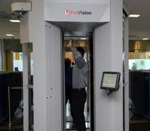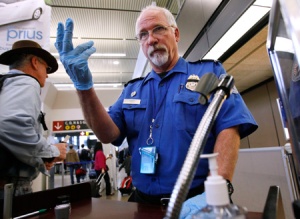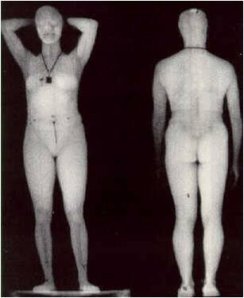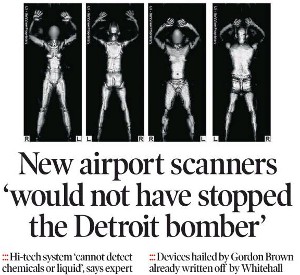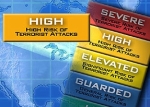From Body Scanners to Brexit and Back Again

Theresa May to Scrap your fundamental rights post Brexit
Between 2010 and 2013, members of this group fought tooth and nail to rid the UK of the ‘No-Scan / No-Fly’ rule imposed on UK air passengers. The ruling, put in place by the then Brown government, in the wake of the Underwear Bomber incident, meant that all passengers could be subjected to a compulsory body scan or lose their flight. We felt that the ruling was unfair, disproportionate, a risk to fundamental human rights, a risk to public health, and a contradictory security measure.
Over a period of 3 and a half years, we lobbied and petitioned the EU and the European Commission to finally come to a decision on body scanner use. Eventually, the EC ruled that Backscatter radiation scanners (in use at Heathrow and Manchester airports) were a risk to public health and should be banned. They have subsequently been banned all around the world. They also agreed that the No-Scan / No-Fly rule was coercive and therefore in violation of the European Charter of Human Rights, not to mention the almost identical UK version of the charter.
In 2011, when this ruling was finally passed, the UK Conservative government decided to ignore EU law claiming they were under more of a threat from terrorist attacks than the rest of the EU. The EC said and did nothing. Thanks to the dogged perseverance of one of our members who petitioned the EC to apply its own law, the European Commissioner for transport finally contacted the UK Home Office and the next day, the No-Scan / No-Fly rule was lifted.
What does Brexit have to do with Body Scanners?
The main battle cry of those campaigning for a divorce between the EU and the UK has always been “taking back our sovereignty”, but what does that really mean? The explanation has always centered on the UK being subject to restrictive EU laws and decisions taken either by the Commission, or by the European Parliament. We know for a fact that high on Home Secretary Theresa May’s agenda has always been the scrapping of the Human Rights Charter. Thankfully for us, she has never been able to do this simply because the EU won’t allow her to get away with such a scandalous and abusive act.
A vote on Thursday 23rd June for Brexit will, without any doubt, result in Theresa May’s ambition to eliminate the Human Rights Charter and open the door to rights abuses on a scale never seen before, and not least those egged on by the security technologies lobby.
The European Union may be considered a debacle, and those of us who campaigned so hard for an EU ruling on scanners can sympathise to some extent with this view, but it is currently our last line of defence in maintaining and further strengthening our fundamental human rights. One of the many dangers we therefore face, is a return to compulsory body scanning.
Please remember this on Thursday June 23rd 2016.
Sam
Terrorist Aliens and other Airport Security Nonsense.

Currently, we are hearing plenty of speculation surrounding the disappearance of the Malaysia Air 370 flight, including ridiculous Bermuda Triangle-type concepts involving aliens, but none quite as fevered in the popular press as the terrorist theory.
Whatever happened to 370 was certainly a tragedy, but to use the event as a means to further the fear agenda goes way beyond anything acceptable in the press.
It is almost as if the ever sensationalist, popular press is praying for another deadly attack against innocent air passengers in order to sex up their headlines. Because nothing sells newspapers quite as much as the image of a good old James Bond-style villain hidden away inside a secret mountain bunker, giving orders to unquestioning agents of terror from his leather swivel chair while stroking a fluffy cat.
The concept is every bit as preposterous now as it was with the invention of the Bin Laden story, and I think I speak for most reading this when I say we are all beginning to become a bit jaded by this over-the-top fantasy. This outlandish conspiracy theory just does not wash anymore! Let me explain why.
There are no terrorists!
Get over it!
“But how can you say that Sam? Of course there are terrorists!”
People like religiously clinging onto this concept, feeling comfort in the knowledge that bad guys exist, especially the easily identifiable, dark-skinned ones. They also like to think that we are somehow on the “heroes” side without ever having to do anything to demonstrate it. What better way to excuse our own inability to improve our lot!
And how embarrassingly little we have progressed!
500 years’ ago, when crops failed or disease struck a community, we dealt with it by burning witches. And if the same misfortune befell us the following year, it must have been because there were more witches out there that needed burning. Does this sound familiar yet? The over-zealous War on Terror is no different. Nothing rallies a community into sharpening their pitch forks like blaming an esoteric and furtive phantom threat that can never really be pinned down.
Most people seem not only prepared to accept much of today’s airport security overreach, but also they insist on its application. When TSA head John Pistole called for a lifting on the ban on pocket knives, there was public outrage, not because they had been conned by their government into believing a nonsensical threat to their safety, which Pistole clearly did not believe himself, but because they have little or no real idea about the functioning of an airport and how the only secured point is at the passenger entrance. I have worked at airports and seen how incredibly easy it is to simply stroll in through the back door.
At any airport, no matter how big or how heavily flagged it has been by government security agencies, the perimeter is enormous and almost impossible to police. Scores of companies with hundreds of employees have constant access with the mere swipe of a magnetically-banded card. In many cases, not even a card is necessary. I have observed these entrances and I bet you that you could just wear some kind of overalls, carry a clipboard and wear some kind of name badge, and no matter what airport you are at, be able to wander right up to a refueling 747 while hundreds of passengers are boarding. Trains are even easier targets and just as spectacular. But, it just doesn’t happen. Why not when the “Terrorist threat level” peaks so frequently into the red zone?
I have also worked in other places where the threat of terrorist acts is taken a whole lot more seriously. The attitude is noticeably different. The fact is that airport security know that trying to secure an airport is like kicking water uphill – it’s an enormous effort with no results at the end of it. But those places that have had credible threats posed against them, seem to manage security with more than just the theatrics we see when trying boarding a flight.
So, why don’t these terrorists do just that? Why don’t they attack planes and trains everyday? It doesn’t take a genius to work it out how easy it is, just someone with a few hours to plan and prepare. I’m left with just one explanation: no one really wants to do it! Or, in other words, today there are no terrorists!
“What about 9/11? What about Madrid 3/11? What about London 7/7?” I hear you cry. The evidence in each of those cases has always been questionable. It’s not that there was not enough security in place on those awful days, all the familiar security measures were there, but switched off. Ask yourself where the CCTV footage is showing the terrorists boarding the trains and planes? We are told that the thousands cameras installed at a cost of millions were coincidentally not working precisely at those moments. So, if the very basics of security were not being used then, how will further layers and technology improve security in the future?
But the press, airports and governments continue to scream “terrorist” as soon as anything goes wrong with air travel. Why? Who benefits? If would-be terrorists have no statement to make by attacking public transport, why do we continue with ridiculous levels of airport security?
Airports are under increasing pressure from competition and their margins are tightening. Replacing security staff with body scanners is one way they can help reduce short-term costs. But you are not interested in their profit margins, are you? So, out comes the “terror” card once again as they tell you it is for your “safety”.
. . .
It is time to rethink security, especially anti-terrorist measures.
Now that the shock and awe sensationalism of the pre-Iraq war attacks has died down, it is high time rationality re-entered the public conscience. We all need to reevaluate what safety is and how we want to achieve it. If nothing else, the terrorist attacks of the last decade should have taught us that we cannot rely on just our governments and some guys in cheap blue uniforms to do the job. Surely, it must be time to start from scratch and reassess what the real threats are to us and our families, put a little perspective on the topic and work together to resolve whatever situation might exist. Government does not include you in that process. On the contrary, the War on Terror has been entirely exclusive of us. Which is partly why crying wolf every time something goes wrong with a flight, is no longer believable.
Sam
Winning!
I am pleased to announce that as from the 22nd of November 2013, the UK government’s “No Scan / No fly” rule in which air passengers who refuse to pass through a body scanner were refused the right to fly, is to be scrapped.
The rule, which has been in place at UK airports since February 2010, was deemed to be illegal by the European Commission earlier this year and as a result the Secretary of State for Transport (UK) has just announced that passengers will have the choice of an alternative pat-down screening procedure.
This is marvelous news and in my opinion marks the beginning of the end of this Draconian security measure.
I would like to give my heartfelt thanks to everyone who has been involved in this campaign over the last four years, from signing petitions, lobbying MPs and MEPs, writing to airports, airlines and government departments, participating in the public consultations and generally spreading the word about the dangers of this technology. It has been a hard, drawn-out battle, but we are finally beginning to win!
However, while the battle may be won, the war is not over yet. We still need to fight the No Scan / No Fly rule in Australia and we still need to alert the public all around the world to their rights and convince them to exercise their right to opt out from the scanning process.
Well done everyone!
https://www.gov.uk/government/speeches/airport-security-scanners–2
“No Scan / No Fly” Rule Illegal Says EC
The “No Scan/No Fly” Rule is ILLEGAL
Scrap the Scanners can now exclusively reveal that the ever dithering European Commission has finally concluded that the UK government is guilty of breaking the law with its No Scan/No Fly rule at 12 UK airports.
In an email to this group, the Commission has stated that the UK is currently breaking a 2011 European law that insists on airline passengers having the right to opt for an alternative screening method other than passing through the controversial full-body scanners.
The government was informed by the Commission on the 8th of July of the illegality of its overzealous security practice and has been given until the 31st of December to comply with the European legislation. What happens next is in the UK’s court.
The polemical airport security rule that forbids those passengers who refuse to pass through a full-body scanner from boarding their flight has been in place since early 2010, while most other countries that mandate body scanner use have allowed their airports to offer a pat-down alternative. Currently, Australia is the only other country that employs a system of compulsory body scanning.
The EU legislation, which came into effect in late 2011, also prohibitted the use of the backscatter xray scanners. While the UK government did eventually rid their airports of this type of technology, it is unclear to why they have not yet come into line with the mandated right to offer an alternative screening method.
Manchester airport had originally been encouraged by the government to extend its investment in backscatter scanners, a technology with a reported lifespan of 5 years, but were forced to scrap their 19 scanners after little more than one year of use. The EC decision could further embarrass the UK Department for Transport as it has recently mandated the use of Millimetre Wave scanners at an extra 9 UK airports and, given the option, it is doubtful that most passengers would opt for the scanners over a conventional pat-down.
If the UK decides to obey the European rules on scanner use, we may begin to see the end of full-body scanners altogether at UK airports. When Manchester was forced to scrap their 19 backscatter scanners, they replaced them with only 3 of the millimetre wave type scanners, which suggests that the airport may be returning to more conventional and less intrusive screening methods.
Sam
Ever since Steven Smith took out the first patent on a full-body scanner back in 1997 the device has occupied a legal and political limbo, a grey zone where law makers really don’t know what to do with it or know what it means for society.
Smith’s original intention for the scanner was to sell it to high-security centres such as prisons, diamond mines and military instalations, but no one was interested. Pre-9/11, Rapiscan, branch of OSI systems, was competing in a highly competitive security equipment environment and was searching for a flagship product that they would market to airports and that would give it the edge it needed to survive. But not even 9/11, nor the attempts of the bumbling Shoe Bomber, proved enough to politically bypass both health and privacy fears. The product was good, by far the best below-clothing imaging device ever to come onto the market, but politicians and airport owners alike all prefered to err on the side of caution.
In 2003 Rapiscan met its first real competitor in the form of the L3 Millimeter Wave scanner. L3, born of ex-Lehman Brothers and Lockheed Martin chiefs, already had the lobbying muscle and managed to persuade UK transport police to trial their product at London rail hubs. Their scanner was nowhere near as efficient as the original Rapiscan device and it was considerably more expensive, but L3 had the contacts and OSI Systems was gradually being dragged down by Rapiscan’s failure to compete against the newcomers.
By 2009, Terror Fever, sparked by the September 2001 televised terror spectacular, was beginning to lose airtime on the BBC and CNN and airports could no longer see the impetus to install such invasive technology without the green light from their governments. Heathrow and Manchester airports had tentetively agreed to run trials with the Rapiscan scanner, but no one else. They, like everyone, awaited some sort of political seal of approval. In Europe, the European Commission’s Siim Kallas attempted to push legislation through the Parliament, but lack of knowledge about the scanners, both for and against, failed to achieve the votes necessary. The scanners remained in limbo while OSI Systems’ share price plummeted. So, Rapiscan met with the Chertoff group, headed by Patriot Act author Michael Chertoff, and comprised mostly of ex-CIA heads. It was an act of desperation on Rapiscan’s part and akin to having a sit-down with protection racketeering Mafia bosses (read more).
Then, the underwear bomber changed everything.
…
Siim Kallas – Political drudge and shuffling goon
Unelelected overseer of European Union Transport policy, Siim Kallas has remained the central keyholder to the scanners’ political limbo. European opinion on the subject has been fundamental to both for and against camps in the body scanner argument. Even the US has waited baited breath to see if the old continent would approve the technology. Post underwear bomber incident, Secretary of DHS Janet Napolitano finally decided to bypass the European Commission and got together personally with EU ministers at two meetings held in Spain in early 2010. The then Spanish minister of Infrastructure, José Blanco who had originally refused to adopt a scanner policy, said that scanner implementation would be “inevitable”.
Kallas and the EU continued to dither. Common rules were demanded and after dragging his heels for a year and half, the commissioner finally put through his long awaited standards on scanner use. He did so slyly when MEPs were leaving for their summer holidays using the Comitology process in which MEPs can only vote against a Commission bill. In their vacational absence, few did.
The new legislation outlawed Rapiscan’s backscatter xray scanner on health fears and demanded alternative screening methods for those not wanting to pass through the scanners. However, it was not until late 2011 when the legislation finally came into effect until Kallas called on SCENHIR, one of the EC’s health risk assessment teams, to verify his claims against backscatter technology as a health risk, something they too failed to confirm either way.
By mid 2011, Manchester airport in the UK already had already overconfidently invested in a total of 19 of the Rapiscan scanners while Heathrow’s backscatter scanners were coming to the end of their 5-year useful life. With the new legislation in place, Heathrow decided to replace their old Rape n’ Scam scanners with the L3 model which evaded health-risk evaluation through a technicality of the classification of the type of energy it uses. The UK Secretary of State for Transport, eager to defend Manchester’s investment, met in private with Siim Kallas just days before the new legislation came into effect. Kallas subsequently signed off an agreement to exempt Manchester from the EU ban for another year. I wonder what was said at that meeting to change the Commissioner’s mind.
Since then, Kallas has continuously failed to answer parliamentary questions on scanner policy and his turning a blind eye to the UK government’s flouting of EU law.
…
Inconsistency and total lack of coherent policy at the UK Department of Transport
In 2012, when Manchester was finally forced to get rid of its 19 backscatter scanner investment citing the new EU rules, they only replaced them with 3 millimetre wave scanners. Why so few after lauding the importance of scanning with 19 Rapiscan scanners before? Could the purchase of the new scanners simply have been a token gesture?
After totally ignoring the results of a public consultation which showed an 80% rejection of the UK’s body scanning Code of Practice, ex-Secretary of State for Transport, Justine Greening, ploughed ahead with her plan to install scanners at even more UK airports. Stansted, Glasgow, Edinburgh, London City and Birmingham were among airports apparently forced by the DfT to initiate scanner trials. But with only one scanner at Stansted compared to the 19 that Manchester had, consistency in policy remains strangely lacking. Stranger still is how London Luton airport, the UK’s 5th busiest airport still evades scanner installation.
This apparent lack of consistency begs the question of whether the UK government has any type of real policy regarding anti-terrorism measures.
One consistent aspect of British body scanner use is the no scan / no fly policy. Flouting EU legislation which demands an alternative screening method for passengers who wish to opt out, the UK remains the only country in the EU prepared to break European law and force both adults and children through the scanner, blackmailing passengers with the threat of losing their flight. Commissioner Kallas remains silent on the issue in spite of continued demands by MEPs to explain his silence. Is he complicit or is he incompetent? Only time will tell.
…
Napolitano bows out while the backscatter timebomb keeps ticking.
Right from the start, Janet Napolitano, head of the US Department of Homeland Security, has been the biggest fan of full-body scanning, overseeing the installation of hundreds of the devices at all US airports. In late 2012, the TSA quietly admitted that they were to scrap their multi-million dollar investment in Rapiscan’s xray backscatter scanners in favour of L3’s model which now came with “privacy-enhanced’ software that Rapiscan had been unable to develop. But L3’s software had been proven to be duff on countless occassions by the DHS’s own agents who, during tests, had been able to easily evade detection of their hand guns through the scanners. Something was amiss.
More recently, and to the total surprise of most in government, Napolitano has announced her plan to resign her post at the DHS in favour of a university job.
The EU’s rejection of backscatter scanners had been due to health fears as well as the UK’s reason for respecting only this part of the EU’s new rules on scanners. Could Napolitano, Kallas and the UK’s Department for Transport be sitting on information about the backscatter scanners? Could they all be preparing for a coming storm – one related to health fears that Kallas cited in spite of SCENHIR’s assurances?
[**update** Reports are emerging that Janet Napolitano has just been accosted at the hands of her own TSA agents. Well, it put a smile on my face!]
Watch this space and watch those cancer figures. I smell a news story is in the post.
Confusion and Contradiction – a story of utter inconsistency in the Body Scanner programme
Confusion and contradiction – This is the only possible way to describe the current global situation regarding full-body scanners. In spite of claims by the US Department of Homeland Security and the European Commission to be striving for a “harmonized approach” to security, the global position could not be more disjointed. The US, for example, has body scanners at all of its international airports and offers passengers a possibility to opt out, while the UK, with its so-called “special relationship” with the US has body scanners now at only seven of its international airports and no possibility to opt out. Australia also has a ‘no scan / no fly’ policy but excludes children from patdowns and scans, while the US and UK make a special point of fully screening child passengers. “Harmonised”?
Then there is the on-going saga of Millimetre Wave scanners: After German and Italian authorities had trialled this technology and found it to be “slow, ineffective” and in the case of Hamburg airport trials, “useless”, the UK and Australia began installing the scanners referring to them as “essential”.
Go figure!
The last few months have seen a string of news events around the body scanner debacle that suggest all is not right with the Orwellian strip-searcher:
…
Backscatter gets the red card
Finally, it seems that the dangers of using backscatter X-ray scanners have been heeded by the politicians on a global scale, a reason for some of us to celebrate, perhaps. The excuse given in the US was that they (the TSA) wanted to replace the backscatter scanners with more “privacy friendly” scanners. Rapiscan, the main producer of the backscatter scanners, is currently being investigated following being accused of falsifying information regarding their attempts at so-called “privacy friendly” software. All this only a year after they were discovered hiding information on the levels of radiation emitted by the Secure 1000 scanner.
All the while the so-called “useless” Millimetre Wave scanners, the ones that failed to detect the Underwear Bomber in 2009, are being spread at a breathtaking rate to all US and UK airports.
Although the UK and US feel the need to protect their airspace from suicide bombers with these so-called “essential body scanners” for flights leaving their shores, there remains no such scanning procedures on most incoming flights, including such important source airports as Hamburg, Paris, Brussels, Madrid or Milan. Considering that this latest push to install scanners was based on the apparent threat posed by terrorists with explosives in their underwear on incoming flights, I am left asking just how ‘essential’ these intrusive scanners really are.
And let’s not forget perimeter security at the same airports with scanners. While airports may be investing millions in keeping potential terrorists from jumping the fence, their technology has been proven again to be useless as demonstrated recently by a New York man found strolling accross the runway at JFK!
…
The Manchester Airport Case
After Heathrow decided to discontinue their use of Rapiscan’s backscatter X-ray scannersdue to “pressure” from their customers and the fear of negative health effects, Manchester airport, with its 19 £180,000 ionising radiation scanners, was left as the only place in Europe still with these scanners. They had already tried to justify their choice of scanner by claiming that the alternative Millimetre Wave scanners did not meet their needs. But now we find a situation in which the European Commission has forced MAN to deinstall their radiation scanners and the airport’s management, as a result, has now opted for exactly the type of scanner they had originally claimed were no good.
Then, there is the European Commission (EC). As previously mentioned on this blog, the ever inept Siim Kallas, Commissioner of Transport at the EC, banned the backscatter X-ray scanners in 2011 and only then called on SCENHIR, the scientific committee to test if his accusation against this technology had any validity. The committee came back with its usual ditheringly vague response that could have been interpreted either way. But Siim said nothing. Manchester celebrated the results of the SCENHIR studies as a victory for the “Radiation? – No Pasa Nada” camp, and the Commissioner made no move whatsoever.
…
Further Roll-Outs in the UK …. 3 Years Late
“Essential”? That is the adjective most frequently used to justify the latest deployment of body scanners at Edinburgh, Glasgow and Birmingham airports, the first deployments in more than 2 years. The reasoning is still the same – the Underwear Bomber incident of December 2009. But is it really that essential that only 7 UK airports are using scanners three years later? And that is without mentioning the incoming flights without any body scanning processes.
The BBC has just announced the latest scanner installation at London’s Stansted Airport – an L3 Millimetre Wave scanner with Automatic Threat Detection (ATD) software that enables the airport to scan passengers without having to show the naked images. The technology is exactly the same that was trialled at Paris CDG and discontinued after 6 months, exactly the same as was trialled at Milan’s Malpensa airport and claimed to be “slow and ineffective” by the Italian Aviation Authority and exactly the same trialled at Hamburg airport and dubbed “useless” by the German police after it gave an 80% false positive rate. The only difference is that at Stansted, the scans will be compulsory.
…
The Illegality of the UK No Scan/No Fly policy.
“It’s not us, it’s the government”. That is and always has been the defence of UK airports operating body scanners and the ‘no scan/no fly’ policy. Their PR departments work overtime to overstate that it’s not theirs but the government’s fault that there must be a no sympathy politic against those who attempt to defend their basic rights. But if “the government” insist that an airport must rabbit punch every other passenger before they board their flight, should they still do it?
The ‘No Scan/No Flight’ policy is blatantly illegal. Currently, a woman who works with the Islamic Human Rights Council is suing the UK government over her being denied the right to fly when she refused to be scanned at Manchester airport. At Stansted, where the ATD software is in use, the flight ban on potential abstainers is coercive and against recently introduced European rules.
Legal definition of “coercion” – noun [mass noun]
- the use of express or implied threats of violence or reprisal (as discharge from employment) or other intimidating behavior that puts a person in immediate fear of the consequences in order to compel that person to act against his or her will
see also
the defense that one acted under coercion
see also defense duress
compare undue influence
If the use of these scanners is so “essential”, then why has it taken almost 3 years since the Underwear Bomber incident to introduce these scanners in Australia and at UK international airports Edinburgh, Glasgow, Birmingham and Stansted? Even during the heightened security procedures of the Olympic games when ground to air missiles were deployed on residential tower blocks, body scanners were not seen as a necessary method of screening passengers.
So, we have a ‘harmonised approach to airport security’ with each country doing something different with body scanners, we have the Underwear Bomber still being used as reasoning for installing apparently “essential” scanners 3 years after the event without any significant investigation into the real failings of security on that day, and we have lawmakers in the UK blatantly breaking the law while lawmakers in the European Union who write the legislation do nothing to uphold it.
Confused? So you should be!
Happy flying!
Sam Edi
(Scrap the Scanners)
Are Body Scanners about to Become Extinct?
Something is amiss in the Body-Scan plan. Governments appear to be backing out of scanner deployment. Do they know something we don’t?
Directly following the Underwear Bomber farce in December 2009, the UK jumped up like a yapping dog after a bone to the US’s call for body scanner implementation. Heathrow and Manchester airports had already begun trials with the scanners and the UK Department for Transport immediately announced plans to install more scanners at Gatwick and Birmingham airports. There was a slight amount of opposition at the time from the likes of the Equality and Human Rights Commission as well as the Islamic Human Rights Council, but generally speaking, all the usual Rights Campaigners kept quiet. After all, who had the balls to dare question the US-led War on Terror?
The US made no bones about their “need” to embark on a mass-scanning programme and ploughed ahead installing body scanners at all their international airports, all at the behest of Scanner lobbyist Michael Chertof, of course. Initially they all scrambled to buy Rapiscan’s Backscatter Xray machine just like Heathrow and Manchester airports in the UK for its superior imaging abilities.

EU government heads meet with DHS head Janet Napolitano. All would leave this meeting to announce scanner deployment
Europe was blackmailed into toeing the line to the minimum requirements of Janet Napolitano, head of the US Department of Homeland Security. The then Spanish Development Secretary had already stated that scanners would not be installed in Spain, and then a few weeks later after meeting with Napolitano, he back-peddled and said that scanners were going to be “inevitable”. France, Germany and Italy all followed suit and pledged to run trials, while Holland and the UK promised to add even more scanners to their arsenal.
However, in spite of the Brown Government in the UK expressing a drooling eagerness to spread the Scan-Plan all over the UK, reticence rapidly set in. Gatwick quietly and tentatively installed Millimeter scanners in June of 2010, but Birmingham airport was eventually left untouched. Why? And why is it that no other UK airports have been forced to buy scanners since then?
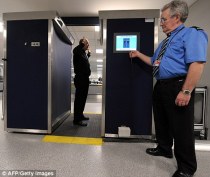 A curious side note: I happened to be travelling through London Luton airport days before the Underwear Bomber incident took place in December 2009. In the arrivals hall, just after Passport Control and before Baggage Reclaim, I noticed a large, wardrobe-sized blue box placed against a wall. Even though this was before I had taken an interest in the body scanners and this campaign, I instantly and inexplicably knew what it was. Two weeks later I was able to put a name to it: The Rapiscan Secure 1000 Backscatter body scanner. What was it doing there? Why has Luton airport never used scanners since then? Was it in transit from one airport to another?
A curious side note: I happened to be travelling through London Luton airport days before the Underwear Bomber incident took place in December 2009. In the arrivals hall, just after Passport Control and before Baggage Reclaim, I noticed a large, wardrobe-sized blue box placed against a wall. Even though this was before I had taken an interest in the body scanners and this campaign, I instantly and inexplicably knew what it was. Two weeks later I was able to put a name to it: The Rapiscan Secure 1000 Backscatter body scanner. What was it doing there? Why has Luton airport never used scanners since then? Was it in transit from one airport to another?
So, what happened to the Scan-Plan UK? The US was still salivating over scanners and buying hundreds of them, but. the UK stopped dead in its tracks and appeared to be waiting, but waiting for what? None of it made any sense.
Eventually, the European Union felt compelled to get involved and the European Commission took what seemed an eternity to bring out a new bill on scanners. Meanwhile, France, Germany and Italy had already run trials at their airports so to keep their deal with the US government and had all finally concluded that the scanners were slow, inefficient and “useless”.
All the while, the UK made no move whatsoever in either direction. Although they had run no efficiency tests on the scanners, or at least they had not made the results of any testing public, they neither made good on their pledge to install scanners at all UK airports. But on the other hand, nor did they retire any existing scanners. Whatever it is that is holding the UK government back is also deterring other EU states from scanner installation.
The UK was the only country in the EU permitted to use Backscatter scanners in that it was one of the few European states that does not have constitutional rules banning the use of ionising radiation for anything other than medical purposes. The Backscatter scanner was clearly the better product in terms of under-clothing image quality, but there was now more trepidation over using it as more than half of US airports were, by late 2011, tending to opt for the lesser effective Millimetre wave scanners.
The European Commission took almost two years until they finally sneaked in their new legislation banning the use of the Backscatter scanners installed at Heathrow and Manchester airports. In spite of this and in spite of a public consultation which gave a reported 80%+ opposition to the scanner use in the UK, the Secretary of State for Transport remained as hard-headed as ever and pledged to continue expanding the compulsory Scan Plan and therefore blatantly breaking EU law. But almost one year on, no more UK airports have received delivery of scanners. Do you get the feeling yet that we are missing some vital information here?
Last September, The European Commission called upon its scientific committee SCENIHR to examine the risk of backscatter scanners to public health. This incompetent and arrogant committee couldn’t be bothered to even run tests on real scanners and only used existing data based on medical Xrays. Even though their report appeared to suggest that the scanners were “safe”, even for pregnant women and children, the UK government, who had been waiting for the report’s publication before progressing with their scanners plan, failed to react in any way to the report. Nor did the EC or the European Parliament.
The EC’s new rules had also given the green light to all EU airports to use Millimetre wave scanners, but none have taken the opportunity to use them.
Simply said, the UK government has not furthered its scanners plan in more than 2 years in spite of publicly and politically favourable terms while other EU countries, including Finland, France, Italy and Germany have all since rejected the scanners due to their enormous inefficiency.
Backscatter scanners? Is there something we should know?
Under pressure from (“ahem”) their customers on their website, Heathrow decided to stop using backscatter scanners in favour of the less dangerous and less effective Millimetre Wave scanners, even though the EC’s science committee had declared the Xray scanners safe.
For the last six months, the TSA in the US have been phasing out Backscatter scanners in favour of Millimetre Wave scanners with Automatic Threat Detection (ATD), a computer algorithm for automatically detecting possible “threats” hidden below passengers’ clothing. The TSA is well aware of the fact that the Italian air authorities have declared this technology “ineffective” and that the German Transport Police have called it “useless” and they are very well aware that blogger Jonathan Corbett very publicly demonstrated that the technology is far less effective than traditional and cheaper metal detector arches, but they still continue replacing Backscatter scanners with this “useless” and expensive equipment.
Considering that each of the Backscatter scanner unit costs between 120 and 180 thousand pounds a pop (well over $200,000), why has the UK’s faith in this technology waned? And why are the TSA trying to phase it out less than 2 years after they began deploying them all over the States? What’s wrong with this technology? And the fact that they are trying to replace the Backscatter scanners with the obviously pointless ATD scanners that are less effective than metal detectors, must tell us something about the real agenda and the real threat level.
I smell a damage limitation exercise in use here. Millions of men, women and children have been scanned in the backscatter scanner with cancer-causing ionising radiation. On top of that, no one has expressed any interest in the latest slimmed-down version by the original scanner inventor Steven Smith. So what’s all the reticence now?
Considering that the ATD Mmw scanners are uselessly ineffective, could we be witnessing the death of the body scanners at our airports?
I think its time to add up the cost of these scanners and decide whose heads must roll.
Sam Edi
Scrap the Scanners
Who Really Benefits From Body Scanners?
Who really benefits from body scanners?
Do we, the passengers benefit from the peace of mind that a terrorist might be impeded by scanners? Do the airlines benefit from scanners, or the airports? Our governments and media may like pushing the idea that everyone is happy with electronic strip searches, but who is really calling for scanners to be deployed at all transport hubs?
Passengers
 The idea is that passengers are both protected from potential terrorist attacks and/or at least are reassured that their safety is being considered. In 2010, the BBC lauded the results of a survey that found that the majority of the flying public was in favour of the measure. But can we trust the results? What the BBC failed to mention was that the consulting company which carried out the survey, Unisys, had financial interests in the body scanner industry.
The idea is that passengers are both protected from potential terrorist attacks and/or at least are reassured that their safety is being considered. In 2010, the BBC lauded the results of a survey that found that the majority of the flying public was in favour of the measure. But can we trust the results? What the BBC failed to mention was that the consulting company which carried out the survey, Unisys, had financial interests in the body scanner industry.
The UK Secretary for Transport, Justine Greening also claimed that most passengers were in favour of the scanners. Her claim was based on a survey carried out at Manchester airport by the airport’s own management. Anyone in Market Research will tell you that this would be an invalid study as the many of the same passengers questioned in the study would have already had to convince themselves that the scanners were OK in order to buy their ticket in the first place.
So, are passengers really reassured that the scanners have been put in place for their protection? The only ‘official’ UK survey into public opinion was the Department for Transport’s 2010/11 public consultation on the code of practice for body scanner use. That one came back with a startlingly different opinion – an estimated 80% against scanners. Greening, however, chose to ignore what the public wanted on this occasion and simply reiterated Manchester airport’s survey results.
And are passengers any safer with the scanners? Health issues aside, as the risk to health has never been adequately evaluated, there is always a risk to our fundamental rights when any new security measure is introduced, especially the right to privacy. But, as everyone knows, there must be a pros-and-cons balance between the risk to our rights and the risk of not having the security measure. The UK has continually exploited a loophole in European law which allows for “more stringent measures” to be adopted due to the government’s claim that their terrorist attack risk assessments come back as being a “high”. However, they have never published, or so much as hinted at what this risk may be or how they came to their conclusions, always citing “National Security” as the reason for their secrecy. Nonetheless, others put the risk of death through an international terrorist attack as being “hardly existential.”
We must also consider the practicalities of these security measures. From removing our shoes and belts, throwing away the expensive perfume and bottle of water, opening our laptops, tasting the baby food to demonstrate it is not a bomb, passing through a body scanner, having our phones swabbed for traces of explosives etc, etc., we are forming ever longer queues at airport security points. Heathrow has been advising passengers to arrive three hours before their flight ever since they introduced scanners due to the extra time it now takes to be screened before we enter the departure area. Passengers at Domodedovo airport in Moscow learned that all these time consuming checks can be fatal when 15 months ago a suicide terrorist with explosives strapped to his body killed himself and some 35 innocent airline passengers waiting to pass through security. That airport also has scanners.
So, if passengers are not benefitting from the scanners, what about the airlines?
Airlines
Since the introduction of mass scanning at US airports began in 2010, followed by the new “enhanced pat-down” for those who opt out of the scanning process, the US airline industry has seen a massive drop in sales as travellers have taken President Obama’s advice and seek less intrusive means of transport.
Ryanair’s chief executive also has spoken out against the scanners claiming that the scanners do not improve security, but pander to the fears generated by politicians.
So, perhaps airport operators are seeing the benefit from scanning millions of their customers each year?
Airports
It is impossible to ignore that fact that Heathrow’s retail revenue has soared since the introduction of these “more stringent” security measures. Not only are sales of already overpriced liquid products such as drinks, perfumes, toiletries and alcohol undoubtedly rising due to not being permitted items at security points, but also during those three hours of waiting before a passenger’s flight, the constant marketing of food, souvenirs and luxury goods has seen a notable increase at the London airport as at all other airports.
But sales of Toblerones and ‘I love London’ t-shirts are not going to cut it for an operation as gargantuan as Heathrow.
Mike Fazackerley, the ex-head of security at Manchester airport, stated there would be great savings for airport operators that adopt scanners. He claimed that the scanners were neither more efficient than conventional pat downs, nor quicker, but he did allude to a saving through a reduction in staffing. Mr Fazackerley was, however, wrong. We estimate that each new scanner deployed at an airport would need between 3 and 6 extra members of staff per scanner. Added to that the fact that each scanner only has a limited useful lifespan of about five years before it needs to be replaced, and we are talking about a serious additional cost.
So far, no one is really benefitting from these scanners, are they?
Security industry
There can be no doubt that 9/11 made a lot of millionaires into billionaires. Fear sells security systems far better than mere prudence, and according to the press and governments, the threat level never drops. There is always another looming threat around the corner and another medicine show of security solutions is thrust into the faces of leaders in every hotel lobby of every capital city.
The London CounterTerror Expo, for example has grown disproportionately to the apparent threat level in the 3 years since its first appearance in 2010, the number of exhibitors has grown from 250 to more than 800, all peddling the latest in scanning technology, detection and hidden recording equipment. From body scanners to iris scanners, facial recognition, puffer machines, etc., all proven to be flawed, all what the politicians refer to as a “layered approach to security”, and all what the American Association of Pilots refers to as nothing more than a “patchwork of band aids“.
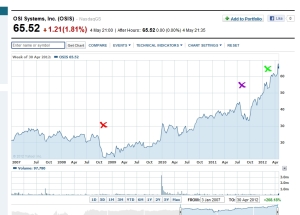 One only has to see the booming shareprice of OSI Systems – principal manufacturer of bodyscanning equipment – to see who is really benefitting from Terror Fever.
One only has to see the booming shareprice of OSI Systems – principal manufacturer of bodyscanning equipment – to see who is really benefitting from Terror Fever.
…
So, the next time one of these inept loons boards a plane with something vaguely resembling a bomb in his underwear and all your rights are suddenly rescinded as yet another new gadget is introduced to strip you naked, ask yourself who really benefits. And ask yourself who could have had the resources, connections, motives to fund, train and put that idiot on the plane in the first place.
The European Commission has finally released its long overdue report on the health risks of using body scanners at airports. They did so in typical fashion late last Friday so to avoid any debate in the press. As expected, the report concluded that there was no threat to health. ‘Expected’ 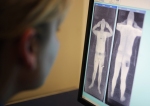 because the Commission’s science committee (SCENIHR) recently admitted to Scrap the Scanners that they had never actually run any physical tests. Their studies were purely theoretical and based on existing information regarding xrays, even though their mandate is to find ‘new and emerging health risks’.
because the Commission’s science committee (SCENIHR) recently admitted to Scrap the Scanners that they had never actually run any physical tests. Their studies were purely theoretical and based on existing information regarding xrays, even though their mandate is to find ‘new and emerging health risks’.
The report was a stitch-up from the outset. The Commission has been seeking to legislate scanner use for 4 years and all their efforts to date have been, at best, underhanded and clumsy.
But what will this mean for the travelling public? Let’s take a look at the current trends and try to read between some of those lines.
The dubious success of OSI Systems

Nicely dressed (left to right) Deepak Chopra, Chairman, OSI Group, L. Satyanarayana, Vice-Chairman and Managing Director, ECIL Rapiscan, and G.P. Srivastava, Chairman and Managing Director, Electronics Corporation of India Ltd (ECIL)
Following buying the patent for the Secure 1000 backscatter (xray) body scanner from its inventor, Steven Smith, the California-based OSI Systems formed its security branch Rapiscan Systems and used the name to market the first full-body scanner which would eventually become its best-selling product. Sales were slow at first as the military and prison services (original target market) showed little interest. So, with the help of the Chertoff group headed by the then US Secretary of State for Homeland Security Michael Chertoff, they began marketing their product as an airport screening method.
Airports and governments alike were apprehensive of the scanner at first, not least because it emitted ionising radiation which is known to cause cancer. The European Commission, however, was all for the idea of scanners and sung their praises in their 2008 report on airport passenger screening. They attempted to push through a new bill on scanner use, but MEPs hated the idea and rejected it. As a direct result, OSI System’s share value plummetted to its lowest value since the creation Rapiscan (see red X) – practically zero! OSI/Rapiscan needed a miracle.
After the conveniently-timed underwear bomber incident at the end of 2009, sales began picking up as the UK and US pledged to buy the Secure 1000 , egged on by Chertoff.
However, the Commission bided its time and sneakily presented its second scanners bill in 2011 by way of the Comitology process. The Comitology process has been frequently accused of being undemocratic and technocratic in that it can be used to introduce new legislation simply by it not being voted down by Parliament. The EC presented the bill and gave MEPs the possibility to reject the proposals at the beginning of the summer when most were already leaving for their holidays.
Nonetheless, OSI System’s investors showed uneasiness at the possibility of the body scanner being rejected by Parliament again and the share price took another hammering (purple X). OSI and their investors knew only too well that Europe was always key to the future of scanners in that if the European Union embraced them, then so would the rest of the world.
Only after the bill got through did the ever inept Transport Commissioner Siim Kallas call on SCENIHR (Scientific Committee on Emerging and Newly Identified Health Risks) to evaluate the health risks. At this point, you would think that the markets would have trembled at the thought of the science committee’s findings … but no. In fact since the study was commissioned, OSI’s share value has doubled! (green X) So, what were the investors privy to that we were not? It makes no sense, especially when you consider the recent rumours that the Transport Security Administration had been on the verge of abandoning the Rapiscan Secure 1000 due to health fears. Investors in OSI have shown particular confidence in the future of the scanner manufacturer in spite of the odds.
So, OSI/Rapiscan are celebrating the fact that their machine has been called “safe” by what they call “another independent study”, conveniently ignoring the fact that at least three other independent studies have concluded that it is not. One such report even claimed that 100 people per year in the US were likely to suffer cancer as a direct result of passing through a backscatter scanner, and that was not counting those who have to work alongside the machines on a daily basis.
What now?
The UK halted its plan to extend the scanners programme to all UK airports in 2010 and last year UK Secretary of Transport, Justine Greening, stated that she was waiting to see the SCENIHR report before taking any further decisions on backscatter scanners. Now the science committee has claimed that the scanners are safe, everyone seems convinced that the UK will continue to oblige airports to install scanners, in spite of the fact that most airport operators seem against the idea.
And then there are what look to be the worst Olympic games ever, with all attention being drawn away from the games and onto the ludicrous ‘security measures’ being put in place. London 2012 currently resembles a war zone more than what it should be – the greatest show on Earth. The UK government has already laid plans to install surface-to-air missiles on the roof of one residential block near the Olympic stadium, even though no one really knows what they will be targetting. We already know that there will be body scans for workers and artists at the events and we also know that Rapiscan has been awarded the contract to be the supplier of security technology. I’m betting on there being scans for visitors as well.
The rest of Europe will likely follow suit and accept the radiation scanners too. In spite of French laws that rule that ionising radiation can only be used in medicine, even the government there has been considering trials with backscatter scanners.
While the threat of transnational terrorist attacks remains ‘hardly existential‘, the scanners are still considered by legislators to be a balanced response. The question still remains after the SCENIHR report to how existential the real risk to public health is. Personally, I believe the real risk to air travel this year to be a tragic accident involving land-to-air missiles and the already overcrowded airspace over London – far greater a risk than any would be underwear bomber, especially when we consider that the latest underwear bomb plot was found to be a CIA hoax.
Duff technology? Who cares?
A recent report out of the US has highlighted the serious failings of the technology and its detection capabilities. This was demonstrated by blogger Johnathan Corbett when he recently managed to pass freely through two types of scanner with a simple metal box in his pocket – something the scanners should have detected with ease.
The report highlighted 8 areas for improvement of the system. However, these recommendations remain ‘classified’. But I do not want to be too negative about this and so I would like to offer the Department of Homeland Security my own 8 reommendations to improve airport security. Let me know what you think Ms. Napolitano:
1) Switch the scanners off and send them to be scrapped.
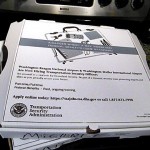 2) Hire professionals to run airport security instead of offering the job to absolutely anyone via pizza box ads.
2) Hire professionals to run airport security instead of offering the job to absolutely anyone via pizza box ads.
3) Sack the current head of the CIA and get someone capable of the job.
4) Investigate previous security failings before taking kneejerk decisions on what should be done.
5) Leave airport security decisions to the experts rather than uninformed politicians.
6) Investigate scanner manufacturers and their lobbyists.
7) Make security inclusive of the public rather than the exclusive to Homeland Security
8) Never buy untested and unproven technology to do the job of professionals.
April 2012
SCENIHR, the European Commission’s scientific committee on emerging and newly identified health risks is poised to present its report to the Commission on the possible health risks of using full-body scanners. The future of scanners in Europe as well as our fundamental human rights are in the balance and this report is likely to tip that balance one way or the other. With rumours rife of scanners being installed at the Olympics this year, the stakes are higher than ever.
But can we trust the politicians to get it right this time or will they follow the UK’s lead in whitewashing over the health risks with political loopholes and secretiveness?
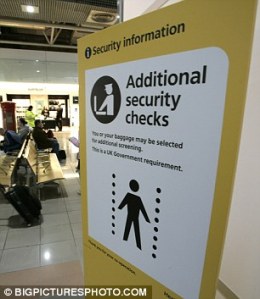 In 2006 when the UK’s Heathrow airport first began trials with backscatter (xray) body scanners, the UK Department for Transport claimed that radiation from these devices was incapable of penetrating human skin. They maintained this claim until early 2010 when the country became the first in the world to introduce a no scan-no fly policy. By then the scanners were featured continuously as part of the fervor caused by the underwear bomber and images of body scans donned the pages of every newspaper.
In 2006 when the UK’s Heathrow airport first began trials with backscatter (xray) body scanners, the UK Department for Transport claimed that radiation from these devices was incapable of penetrating human skin. They maintained this claim until early 2010 when the country became the first in the world to introduce a no scan-no fly policy. By then the scanners were featured continuously as part of the fervor caused by the underwear bomber and images of body scans donned the pages of every newspaper.
Viewing the images, people began to ask “if the radiation does not penetrate the skin, then why can we see areas of the skeleton on the scan?” The DfT quickly deleted their claim from their FAQs page. Later on, Steven Smith, the inventor if this type if scanner said that radiation absorption in fact played a fundamental role in the image making process.
However, the DfT were not ready to give up on their investment and promoted the idea that the scanners emitted so little radiation that they could not be any kind of threat.
But can we really take their word for it? Is the risk balance between the radiation dose and that of exploding terrorists really that justified?
Let’s take a look at the validity of the claim that body scanners are safe.
Do you trust the UK government?
The DfT’s claim was based on studies apparently undertaken by the Health Protection Agency in which a comparitive analisis concluded that the dose from backscatter scanners is equivalent to that received from cosmic radiation received from one minute of a flight. However, some in the scientific community disagree with the comparison in that the two types of radiation (backscatter and cosmic) act differently on the human body.
It has also recently come to light that the HPA has never actually done any testing on any scanner and their claim that the scanners were safe was based purely on information from a third party. This group has spent the last two years continuously trying to obtain information from the HPA, the DfT and the Health and Safety Executive on who did these apparent tests and what parametres and methodology was employed, but to no avail. The UK blankly refuse to reveal the source of their claim and therefore its validity and the impartiality of the third party is impossible to verify. Simply said, the DfT’s claim remains unproven.
The European Commission Debacle.
The Euro scanners debate has been raging since 2008 when the European Commission presented a bill to parliament which would create common rules on scanner use. The members of parliament were horrified at the thought of this technology violating the fundamental rights of air passengers and refused to play ball.
When the young fool Abdulmutallab tried to blow up his underpants on a flight to Detroit in 2009, the debate reopened and the EC revamped their pro-scanners legislation plan. It took until summer of 2011 for the EC to present their new scanners bill to parliament which they did through a comitology process. MPs had the chance to vote against the bill, but of course many were absent due to holidays. The bill was not so much as passed, but got through by not being refused.
On the surface, the EC’s rules appear to be an improvement on the previous situation in that they ban the use of backscatter technology (due to health fears) and demand an opt-out option for passengers, but the European Commissioner of Transport, Siim Kallas, showed enormous ineptitude and granted Manchester airport an exception just two days before the new laws came into effect, leaving Manchester to continue using their 19 £150,000 radiation machines.
On top of this, the EC Vice President did not commission SCENIHR (the EC’s science committee) to investigate the health risks of scanner use until after backscatter scanners had been banned. The results of their studies are due to be published this month (April 2012). However, we are no more confident about the objectivity of the SCENIHR results than we are of the UK’s HPA studies. According to recent correspondance between SCENIHR and this group, the science committee, like the HPA, has not done any real testing themselves and have also relied on information from third parties which they refuse to divulge the name of. Nor do they know the parametres of any testing or whether or not those third parties have any stake in the results of testing. Any claim that SCENIHR will therefore remain baseless.
The SCENIHR opinion is expected around end of April. For this work, the SCENIHR did not conduct any experimental studies but relied on data from third parties and modelling work.
Best regards,
Laurent Bontoux, PhD
Principal Administrator – SCENIHR Management Officer
European CommissionDear Mr Bontoux
Many thanks for your reply. Would it be possible to obtain a list of names of third parties used in SCENIHR studies on body scanners?
RegardsNo, this is confidential.
Best regards,
Laurent Bontoux
Almost an exact mirror of what the HPA had done.
It was always essential to carry out tests on actual body scanners especially after it was discovered in the US last year that backscatter scanners were emitting 10 times the expected amount of radiation. I find it inconceivable that SCENIHR scientists made no attempt to run tests with a real scanner when only one kilometre from their offices in Brussels, the European Parliament building has 6 Rapiscan backscatter devices abandoned in a basement, paid for by taxpayers and never used.
So, we are back to square one and still do not know if the scanners are really safe.
Prepare to be irradiated at the Olympics this year.
Let’s just review the body scanning technology you will need to look out for with a quick look at the main scanning technologies being sold to airports and entertainment venues this year. As NONE of these machines have been tested by SCENHIR, they look unlikely to tell you as much as we will about them. If SCENIHR’s report to the EC turns out to be in favour of scanner use, we can expect a far greater deployment of all scanner types within the EU in the near future. It recently emerged that the UK government plans to deploy scanners at the Olympic games this year to screen workers entering the event zones. Also, Rapiscan, the main manufacturer of the EU banned backscatter scanners has just been awarded the contract for supplying security screening equipment to the games.
…
Backscatter scanner (Rapiscan)
 This scanner, the most successful on the market, projects a beam of ionising radiation over the body from head to toe. The low-power radiation progressively loses penetrative power as it travels towards its subject. In theory, this gives it enough power to penetrate clothing, but not the whole body. Scientists at the University of California are concerned that this radiation not only penetrates clothing, but also skin and then is “deposited” inside the body and therefore doing untold damage.
This scanner, the most successful on the market, projects a beam of ionising radiation over the body from head to toe. The low-power radiation progressively loses penetrative power as it travels towards its subject. In theory, this gives it enough power to penetrate clothing, but not the whole body. Scientists at the University of California are concerned that this radiation not only penetrates clothing, but also skin and then is “deposited” inside the body and therefore doing untold damage.
….
Transmission Scanner (Conpass)
The radiation from this scanner is said to be 8 times the strength of the backscatter model and  therefore capable of exposing internal organs. Until last year, it was only possible to find this product at high-security prisons and diamond mines. This year, Australia intends to transmission scan selected passengers arriving at Sydney airport for contraband.
therefore capable of exposing internal organs. Until last year, it was only possible to find this product at high-security prisons and diamond mines. This year, Australia intends to transmission scan selected passengers arriving at Sydney airport for contraband.
…
Active Millimetre Wave Scanner (L3, Smiths Detection)
Millimetre waves are radio waves which can be found in the range between microwaves and  those emitted by your mobile phone. in this device, a scanner rapidly rotates around the subject, gathering below-clothes information and forming a 3-D naked image. While it is generally believed that this type of radiation does not cause cancer, some believe it may agitate existing tumors as well as cause significant problems for pregnant women and those with pacemakers. Chicago O’Hare airport, for example, reportedly has signs warning passengers with pacemakers not to pass through the scanners, and recently a woman with a pacemaker died after she had to pass through a MMw machine between Gaza and Egypt.
those emitted by your mobile phone. in this device, a scanner rapidly rotates around the subject, gathering below-clothes information and forming a 3-D naked image. While it is generally believed that this type of radiation does not cause cancer, some believe it may agitate existing tumors as well as cause significant problems for pregnant women and those with pacemakers. Chicago O’Hare airport, for example, reportedly has signs warning passengers with pacemakers not to pass through the scanners, and recently a woman with a pacemaker died after she had to pass through a MMw machine between Gaza and Egypt.
The efficiency of this technology has constantly been called into question. The German police called it “useless” and decided to get rid of it. So did the Italian authorities and the British Transport police.
